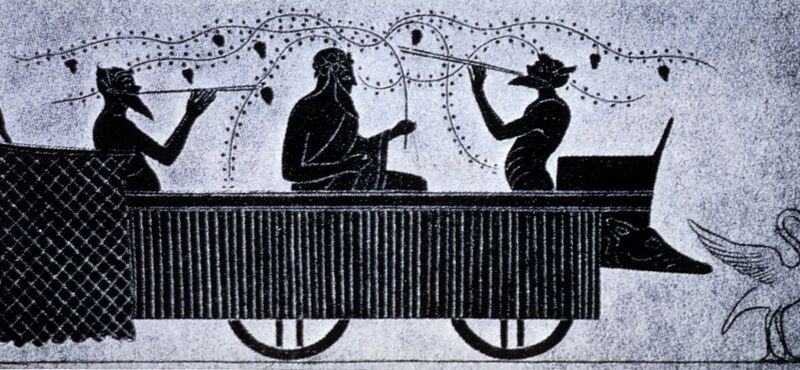The Thespian Cart
Theatre on Tour
Thespis lived in the 6th century BCE, and is said to be the originator of the idea of the actor, of dialogue as part of dramatic performance, and of touring theatre.
The actor Thespis of Icaria, described by Horace in the Ars Poetica, gave birth to the idea of a mass theatre, with a strong emotional impact and capable of conveying theatrical culture to forgotten segments of the population. He lived in the mid-6th century BCE, and had his own wandering company, called the Cart of Thespis, with which he gave dramatic performances in Icaria and other places in Attica. He also acted in Athens, when Pisistratus introduced the cult of Dionysus there and organised the Great Dionysias (festival of Dionysus) of 534 BCE. Thespis performed, for the first time, one of his dramas. He detached from the chorus a character who would ‘answer’ to the chorus and be a real actor: he invented or developed, the dialogic prologue.
Thespis brought other important innovations, involving the makeup of actors and especially the use of the mask. The followers of Dionysus, who was one of the most important deities of ancient Greece, had the custom of masking themselves, covering their heads with leaves and dyeing their faces black or red with soot or rust. Thespis transferred this custom to the scenes, added white to the two colours (for which he used white lead), and then made real cloth masks. Later masks were also made from cork and wood, more durable materials that remained in use throughout antiquity. Thespis thus also introduced into the theatre the suggestive element of fiction, that is, the distortion of reality.
Thespis, after a period of triumphant victories, left Athens to head elsewhere. He departed from the capital on a cart, with a group of actors like himself in tow. With his cart he reached villages, hamlets, inaccessible parts of the Greek countryside: and wherever he arrived he staged comedies and tragedies, written or improvised. And without knowing it, with that act of his, Thespis had given birth to that form of theatre which, for tens of centuries, would be an undisputed success throughout Europe: the wandering theatre – a theatre which does not wait to be reached by the public, but which goes to look for the public, in the most remote recesses of the province and rurality, in the name of an art that is – and must remain – by its very nature art for all and of all. Thespis is, in short, the ideal progenitor of all wandering actors, of all the homeless of stage art, of all those comedians who choose the difficult road of artistic and existential improvisation.
And it was precisely Thespis who would return as the inspirational model for those who, in the 16th century, gave birth to a form of theatre that was at times primordial and at times futuristic – a street theatre, devoid of theatrical buildings, scripts, and acting rules: the Commedia dell’arte, a typically Italian product, later successfully exported throughout Europe and endowed with truly exceptional longevity (H.02). Commedia is, first and foremost, a form of nomadic theatre, a theatre that goes looking for an audience there where it knows it will find one (in the squares, in the markets). The comedian of art, having arrived at these meeting places, just like any other merchant, sets up his stall and, having climbed on it, improvises his art. He later migrates to other shores, seeking new audiences to beguile.
The Cart of Thespis and the Itinerant Theatre came back into vogue with Futurism and Fascism. Fascism made use of this model and the experience of the wandering theatre by constructing an open-air touring theatre project starting in 1929: four huge theatrical structures – three for prose and one for opera – transported on trucks that also took the name of Thespian Carts, conceived by set designer Antonio Valente and Giovacchino Forzano. They travelled throughout the Italian provinces on long tours, capable of involving hundreds of thousands of spectators. The Thespian Carts reached even the most remote localities, normally not involved in significant theatrical events. Here the workers would set up the vast seating banks, capable of holding five thousand spectators, and the large stage was topped by a Fortuny dome, on which many lighting effects could be realised (B.06).
The last of the Carts of Thespis in Italy was by the National Mobile Theatre Company, formed in 1960; it toured the country until 1973. In the summer of that year the company ceased to exist, and the pavilion was donated to those displaced by the 1972 Ancona earthquake. Elsewhere in Europe, other touring theatres, with the same motivation to reach the people where they were, built mobile stages. Against the odds, the spirit of the Cart of Thespis lives on.


